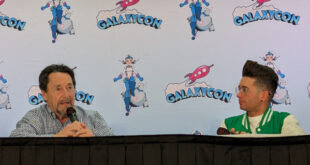BotCon, the original Transformers fan convention, hosted a panel with Bob Budiansky and Simon Furman, with a focus on how they spearheaded the early development of The Transformers comics. In the 1980s, Budiansky worked with the U.S. office of Marvel Comics, while Furman was overseas in the U.K. office.
On the Beginning of ‘Transformers’
In November 1983, Marvel editor-in-chief Jim Shooter needed character profiles for toys that Hasbro bought from Japan. With Thanksgiving holiday around the corner, several writers turned down the assignment until Shooter got to Budiansky.
Accepting this project, Budiansky wrote the character profiles by hand on legal pad paper. He said, “I developed 26 characters. I renamed or came up with names for 24 out of 26 characters, not Optimus Prime, not Prowl.”
Interestingly, Hasbro rejected some of the names, mostly for legal reasons if it was already in use for another cartoon or toy. Memorably for Budiansky, baddie Megatron didn’t make the cut at first because Hasbro considered it “too scary.” However, for that particular toy, he petitioned successfully that Megatron should stay because the main villain “is supposed to be scary.”
Another fun name is Ratchet, which Budiansky took from two sources: the word’s definition and One Flew Over the Cuckoo’s Nest. “It was a good name for an ambulance, somebody who fixes things, and also had a connection to a popular movie at the time that starred Jack Nicholson.”
On Expanding Transformers Mythology
When Budiansky wrote his profiles in 1983, he also wanted to include a couple of female characters. To his surprise, Hasbro turned those suggestions down. They told him, “No, these are boys toys. No females.” Two years later, Arcee arrived in the 1986 film as the first female character.

Budiansky’s contributions went further than the character profiles. He mapped out power ratings, similar to what Marvel was already doing for other comic series. And around 1985, Hasbro and Marvel were done with adapting the Japanese toys. The toy company started designing brand new toys, giving Budiansky unique character lists.
By the time Budiansky finished with The Transformers, he’d developed some 250 characters, including their profiles and names. He wrote for the comic book series, gave outlines to the artists, and sketched cover designs or drew the covers himself. “Hasbro was creating other aspects to The Transformers universe. They would ask me to come up with new treatments to develop the mythology even far even beyond what we had initially.”
On Side Stories with Marvel U.K.
In the United Kingdom, Marvel kept busy with The Transformers comics as well. Simon Furman was on staff there. Editor Sheila Cranna asked him and other writers to generate original story ideas. The Transformers ran on a more frequent schedule in the U.K., so they were going to run out of U.S. comics to republish.
The team decided to create plots on the side characters, fleshing out their backstories and adventures. Furman said, “If Bob marched them off stage left, we would bring them on stage right in the U.K. story. We could be fairly confident that they weren’t going to be used again for a while.”

Later on, Furman was elated during Budiansky’s visit to Marvel U.K. They went to lunch that afternoon. “Bob said to me, ‘You know what? I’m kind of burned out. I’ve written 50-something issues, a few miniseries. We need a new writer. Would you like to do it?'”
On Other ‘Transformers’ Iterations
After Budiansky left The Transformers, Furman kept the original comics going and published about 25 additional issues. Then Furman joined Dreamwave in 2002 and IDW Publishing in 2006 to devise new Transformers comics. He was in awe of the new artists who emerged and knew the 1980s source material quite well.
Unfortunately, some storylines—Beast Wars, Energon, age of wrath to name a few—didn’t get released during these runs. However, Furman is very proud of the projects that made it to print.
“They introduced us to the likes of Don Figueroa, Alex Mill and all these amazing artists we now know today. These were artists who—unlike a lot of the artists back in the day—were willing to put a ton of detail into these characters.”
Furman ended his presentation with some sketches of human characters. “I think the human perspective is really useful in Transformers. It makes the robots themselves seem bigger, more impressive, awesome or inspiring if you have that human viewpoint.”
Visit the BotCon website for more information.
 Blogcritics The critical lens on today's culture & entertainment
Blogcritics The critical lens on today's culture & entertainment




